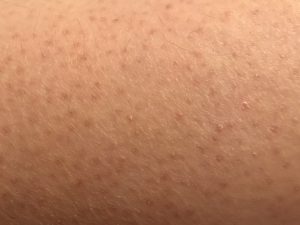 Keratosis pilaris, also known as follicular keratosis, lichen pilaris, or colloquially chicken skin.
Keratosis pilaris, also known as follicular keratosis, lichen pilaris, or colloquially chicken skin.
A common, autosomal-dominant, genetic condition of the skin’s hair follicles.
It is characterized by the appearance of small, gooseflesh-like bumps, with varying degrees of reddening or inflammation.
It is most common on the outer sides of the upper arms.
The forearms, thighs, face, back, and buttocks, hands, and tops of legs, sides, or any body part except hairless skin can be affected.
On the face, it may be mistaken for acne or folliculitis.
Several types of KP are associated with pregnancy, type 1 diabetes mellitus, obesity, dry skin, allergic diseases such as atopic dermatitis, and rarely cancer.
Rarely the disorder are part of inherited genetic syndromes
The cause of KP is not completely understood.
It is thought to be due to abnormalities in the process of depositing the protein keratin in hair follicles, abnormalities in the hair shaft, or both.
KP is usually diagnosed by the appearance of the skin, but dermoscopy can be used, as well, if the diagnosis is unclear.
Patients experience small, rough bumps on the surface of the skin.
They are skin-colored bumps the size of a grain of sand, many of which are surrounded by a slight pink color in light-skinned people and dark spots in dark-skinned people.
Most people do not have symptoms, but the bumps in the skin can occasionally be itchy.
Irritation due to scratching of KP bumps can result in redness and inflammation.
Variants of the ABCA12 gene have been associated with KP.
KP is the most common disorder of the hair follicle in children.
No single approach has been found to completely cure KP.
Treatments include:
the application of topical preparations of moisturizers and medications such as glycolic acid, lactic acid, salicylic acid, urea, or retinoids to the skin.
Fractional carbon dioxide lasers and Nd:YAG laser therapies are also effective.
The condition is experienced year-round, but the problem can become exacerbated, during the colder months, when moisture levels in the air are lower.
The symptoms may worsen with pregnancy or after childbirth.
Increased sun exposure might mitigate the symptoms of KP.
KP produces excess amounts of the skin protein keratin, resulting in the formation of small, raised bumps in the skin, often with surrounding redness.
The excess keratin surrounds and entraps the hair follicles in the pore, causing the formation of hard plugs.
This process known as hyperkeratinization.
Many KP bumps contain an ingrown hair that has become coiled, as a result of the keratinized skin’s preventing the hair from exiting.
The hair then grows encapsulated inside the follicle.
It is more common in patients affected by atopic diseases such as allergic rhinitis and atopic dermatitis.
KP subtypes ate part of genetically inherited syndromes associated with intellectual disability, neuro-cardio-facial-cutaneous syndromes, RASopathies, ectodermal dysplasias, and certain myopathies.
It can can often be diagnosed KP simply by clinical examination.
Dermoscopy can confirm the diagnosis and assess response to treatment.
Differential diagnosis
Several medications that can cause a skin eruption similar to KP include cyclosporine, BRAF inhibitors, and tyrosine kinase inhibitors.
Different types of KP include:
KP rubra -red, inflamed bumps, which can be on arms, head, legs.
KP alba-rough, bumpy skin with no irritation
KP rubra faceii, reddish rash on the cheeks
It is commonly seen in association with other dry-skin conditions: ichthyosis vulgaris, dry skin, and atopic dermatitis.
KP does not hav long-term health implications.
KP is not associated with increased mortality or morbidity.
It is not related to goose bumps.
KP is a harmless process, but many individuals may seek treatment, as the condition can cause emotional distress.
Topical creams and lotions are currently used in treatment specifically those consisting of moisturizing or keratolytic treatments, including urea, lactic acid, glycolic acid, salicylic acid, vitamin D, fish oil, or topical retinoids such as tretinoin.
Skin improvement often takes months, and the bumps are likely to return.
Limiting time in the shower and using exfoliation to unplug pores can help,
abrasive materials, with alpha or beta hydroxy acids to assist with exfoliation.
Some cases of KP have been treated with laser therapy.
It is more common in women than in men, and it is often present in otherwise healthy individuals.
It is is prevalent in people of all ethnicities.
It may manifest in people of any age, but usually appears within the first decade of life.
It is more common in young children.
In most cases, it improves before age 30, but it can persist longer.
